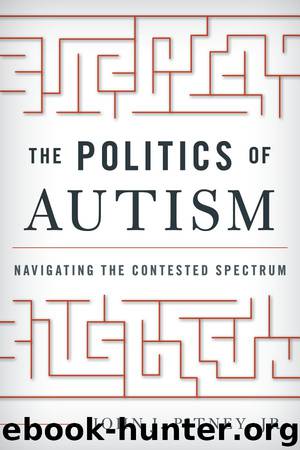The Politics of Autism by John J. Pitney Jr

Author:John J. Pitney, Jr.
Language: eng
Format: epub
Tags: undefined
Publisher: undefined
Published: 2012-04-11T04:00:00+00:00
FAPE and IEP
After the assessment comes the meeting to draft an initial individualized education program (IEP), which lays out the child’s unique needs and the services that the school district will provide. About 80 to 90 percent of autistic children get an IEP. Not surprisingly, one study found that many of the remainder are Hispanic or have mothers with low levels of education.[26]
The IEP process, which repeats at least once every year for which the child is eligible for services, culminates with a written offer of FAPE in the LRE, that is, a free appropriate public education in “the least restrictive environment.” The latter phrase comes straight from IDEA, which requires that disabled children go to school with nondisabled children as much as possible, and that that they attend special classes or special schools only when their condition keeps them from taking part in regular classes.[27] About 90 percent of autistic students under IDEA attend regular public schools, and about two-thirds of these students spend at least 40 percent of their day inside general class.[28] Of those who do not attend regular public school, most go to separate schools for children with disabilities, and a small number get funding to attend private schools. Public charter schools enroll a lower percentage of students with disabilities than traditional public schools, even though the law forbids them to discriminate on the basis of disability.[29] Of more than six thousand charter schools nationwide, about one hundred focus on special education for the disabled.[30] A small fraction of the special-ed charters specialize in serving autistic children.
Schools provide a range of services. One study found that more than four-fifths of preschool and elementary students and two-thirds of secondary students receive speech therapy.[31] The second most common service is occupational therapy, which works on attention span, balance, coordination, sensory processing, fine motor skills such as handwriting, and life skills such as brushing teeth. A related service is adapted physical education, special help for children who have a hard time with running, throwing, catching, and other activities that most kids take for granted. Many students have “one-on-one” aides, paraprofessionals who shadow them through the school day to help them keep up with their schoolwork and manage their interactions with other children. Some districts offer applied behavior analysis, either at school or at home through contracts with private providers.
Lawmakers originally assumed that writing an IEP would be a straightforward matter of matching the services with the student’s needs.[32] If you have read this far in the book, you are probably guessing that this assumption proved wrong. IEP meetings often represent a clash of conflicting outlooks. On one side of the table are parents who want the best possible outcome for their children. On the other side are school officials who are usually dutiful but who naturally see the child as one among many. When they say that they care as much about the child as much as the parents do, the parents are thinking, “Oh no you don’t!”[33] Even
Download
This site does not store any files on its server. We only index and link to content provided by other sites. Please contact the content providers to delete copyright contents if any and email us, we'll remove relevant links or contents immediately.
| Anthropology | Archaeology |
| Philosophy | Politics & Government |
| Social Sciences | Sociology |
| Women's Studies |
The Secret History by Donna Tartt(18846)
The Social Justice Warrior Handbook by Lisa De Pasquale(12141)
Thirteen Reasons Why by Jay Asher(8796)
This Is How You Lose Her by Junot Diaz(6794)
Weapons of Math Destruction by Cathy O'Neil(6146)
Zero to One by Peter Thiel(5686)
Beartown by Fredrik Backman(5599)
The Myth of the Strong Leader by Archie Brown(5425)
The Fire Next Time by James Baldwin(5249)
How Democracies Die by Steven Levitsky & Daniel Ziblatt(5128)
Promise Me, Dad by Joe Biden(5087)
Stone's Rules by Roger Stone(5026)
A Higher Loyalty: Truth, Lies, and Leadership by James Comey(4845)
100 Deadly Skills by Clint Emerson(4840)
Rise and Kill First by Ronen Bergman(4704)
Secrecy World by Jake Bernstein(4646)
The David Icke Guide to the Global Conspiracy (and how to end it) by David Icke(4625)
The Farm by Tom Rob Smith(4437)
The Doomsday Machine by Daniel Ellsberg(4416)
